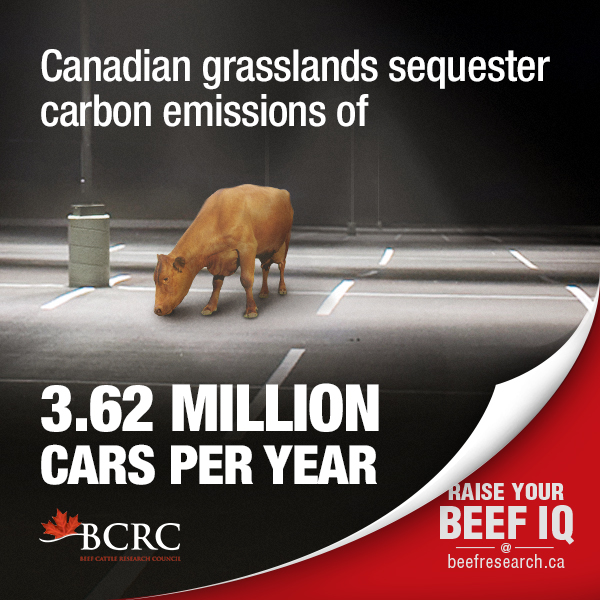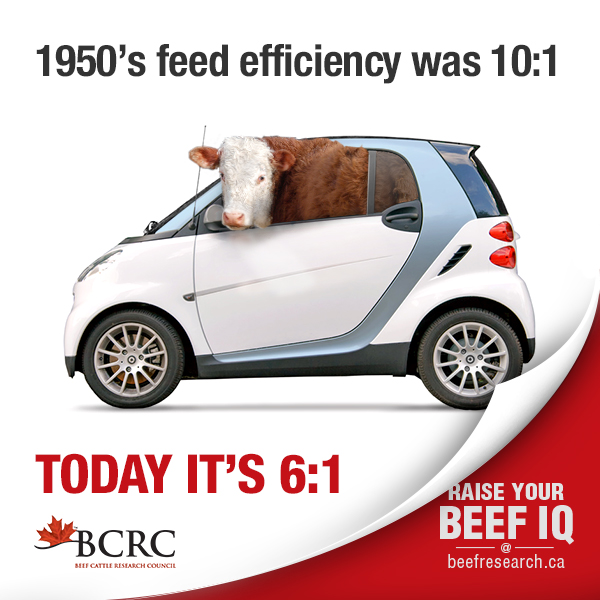This post was written in collaboration with Fawn Jackson, Canadian Cattlemen’s Association Manager of Environment and Sustainability.

Earth Day, celebrated annually on April 22nd, began in the 1970’s and is often cited as the start of the modern environmental movement. But it isn’t just for the hippie children of the 1970’s anymore. Today Earth Day is recognized globally by people from all walks of life as a way to foster and celebrate environmental respect and behavioural changes that lessen our impact on the earth.
Cattle producers across Canada, who chose to make their living as stewards of the land, fully appreciate the value of a healthy environment. For all of us in the Canadian beef industry, Earth Day is a day to celebrate our industry’s environmental achievements, and is an excellent time to foster further discussion about how to make continual improvements in this area.

Canadian cattle producers have achieved great feats of environmental improvement since cattle were brought to Canada in the late 19th century by Americans to southern Alberta. Canadian beef production is now globally recognized as some of the most efficiently produced beef in the world in regards to natural resource use. Several ecological services are provided by beef producers as well. For example, Canadian rangelands capture and store carbon dioxide from the atmosphere, and maintain watersheds, wetlands, and habitat to support plant, animal, bird and insect biodiversity.

Given limited natural resources and a growing population with growing consumer interest in how food is produced, it is imperative that that the beef industry has a comprehensive understanding of its environmental impact. Two research projects are currently underway to do just that.
The Beef Cattle Research Council (BCRC) is funding a project titled ‘Defining the Environmental Footprint of Canadian Beef Production’ led by Dr. Tim McAllister and Dr. Karen Beauchemin at the Agriculture and Agri-Food Canada research centre in Lethbridge, Alberta. This project will examine changes between 1980 and today in the amount (and types) of feed, land and water needed to produce a kilogram of beef.

Furthermore, the study will look at the changes in the amount of greenhouse gas and manure produced per kilogram of beef, as well as changes in water quality, carbon sequestration, biodiversity and other ecosystems services. Learn more in the BCRC’s fact sheet: http://www.beefresearch.ca/factsheet.cfm/defining-the-environmental-footprint-of-canadian-beef-production-138
While the BCRC-funded project brings the historic perspective, another project led by the Canadian Roundtable for Sustainable Beef, will look at the environmental, economic and social impact of the Canadian beef industry today, identify strengths, weaknesses, opportunities and threats as well as set key performance indicators for future benchmarking.
Together these research projects will help to identify potential areas for improvement as well as help acknowledge the achievements that have been made in improving the footprint of the Canadian beef industry.
Learn more
Environmental Footprint of Beef Production
Beef Cattle Research Council
http://www.beefresearch.ca/research-topic.cfm/environmental-footprint-of-beef-production-6
Celebrate the Canadian beef industry’s environmental stewardship today!
Start the conversation with consumers online.
Hashtags: #EarthDay2015, #EarthDay #EarthDayEveryDay #lovecdnbeef #CanadianBeef #farmvoices #AgMoreThanEver #agvocate #agproud #farm365
Add your own photos or the ‘Raise your Beef IQ’ images found here: http://www.beefresearch.ca/resources/images.cfm
Sample Facebook posts:
- Happy #EarthDay2015! Did you know forages (grasses and legumes that feed ruminant animals) provide many ecosystem services to society, including carbon sequestration, biodiversity, wildlife habitat, and nutrient cycling? Forages also improve soil quality, prevent erosion and help manage excess moisture on the land. Many acres of forages are seeded or maintained because they’re relied upon in livestock production, which often utilizes land that is unsuitable for other agriculture purposes to sustainably produce nutrient rich food. [suggest adding photos of your hayland or pastures]
- Happy #EarthDay2015! On our farm we use horses as a part of our #greencommute. [suggest inserting picture of you on horseback]
- It’s #EarthDayEveryDay on the farm. Thanks to everyone who supports Canadian beef. We’re proud to be your farmers/ranchers!
Happy #EarthDay2015 everyone! On our farm we… [insert your own management practice. For example, maintain shelterbelts and healthy riparian areas to help protect habitat for many different species, etc.]
Sample Twitter posts:
- On #EarthDayEveryDay, grasslands preserve wetlands and provide habitat to many species at risk. #lovecdnbeef
- Did you know grasslands for grazing livestock capture and store carbon dioxide from the atmosphere?
- Grasslands benefit enviro thru carbon sequestration, wildlife habitats, biodiversity, healthy watersheds & reduced soil erosion #EarthDay
- If technology was frozen in 1955, we’d need 45 million more acres to produce same about of Cdn beef today. #EarthDay2015
- Thanks to research and innovation, each lb of beef produced today uses 14% less water, 34% less land than in 1977 #EarthDay #lovecdnbeef
- Cdn cattlemen use own $’s to fund research to maximize efficiency, minimize enviro footprint and more beefresearch.ca #EarthDay2015
- Q: How much feed and water are used to make a pound of beef?
A: http://www.beefresearch.ca/blog/cattle-feed-water-use/ #EarthDay #FarmVoices
Start the conversation with other producers online
Hashtags: #EarthDay2015, #EarthDay #agchat #cdnag #westcdnag #ontag #atlcdnag
Add your own photos or the ‘Raise your Beef IQ’ images found here: http://www.beefresearch.ca/resources/images.cfm
Sample Facebook posts:
- Hey cattle friends, today is #EarthDay. Honor it by learning more about taking good care of your land, like manure and nutrient management (http://www.beefresearch.ca/research-topic.cfm/manure-and-nutrient-management-7) or rangeland and riparian health (http://www.beefresearch.ca/research-topic.cfm/rangeland-and-riparian-health-82)
- Hey cattle friends, today is #EarthDay. Find information about the six principles of on farm biodiversity conservation here: http://www.nagrasslands.org/biodiversity-conservation-guide-farmers-ranchers-alberta/
Sample Twitter posts:
- Hey cattle friends, today is #EarthDay. Honor it by learning more about manure and nutrient management http://www.beefresearch.ca/research-topic.cfm/manure-and-nutrient-management-7 #cdnag
- For my cattle friends, today is #EarthDay2015! Honor it by learning more about rangeland and riparian health http://www.beefresearch.ca/research-topic.cfm/rangeland-and-riparian-health-82
- #EarthDay is a good time to be inspired by past winners of The Environmental Stewardship Award: http://www.cattle.ca/sustainability/the-environmental-stewardship-award/tesa-archives/
- #Earthday is a great day to sign up for a summer grazing school! #continuedlearning http://southernalbertagsw.blogspot.ca/2015/04/2015-southern-alberta-grazing-school.html @CowsandFish @MULTISAR @OGC_AB
- #EarthDay is a good day to consider an off-site watering system for your livestock to maintain the quality and supply of water http://cowsandfish.org/pdfs/greenzone/page%2027%20Riparian%20Areas%20and%20Grazing.pdf
- #EarthDay is a good day to connect w/ ag focused enviro orgs like @CowsandFish @MULTISAR @OGC_AB @MBConsDistAssoc#FRISP @SaskPCAP #EFP
Click here to subscribe to the BCRC Blog and receive email notifications when new content is posted.
The sharing or reprinting of BCRC Blog articles is welcome and encouraged. Please provide acknowledgement to the Beef Cattle Research Council, list the website address, www.BeefResearch.ca, and let us know you chose to share the article by emailing us at info@beefresearch.ca.
We welcome your questions, comments and suggestions. Contact us directly or generate public discussion by posting your thoughts below.






